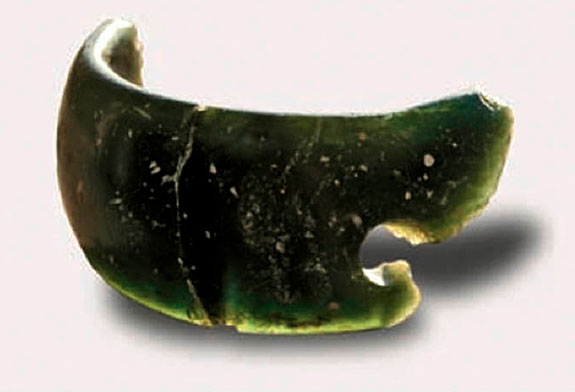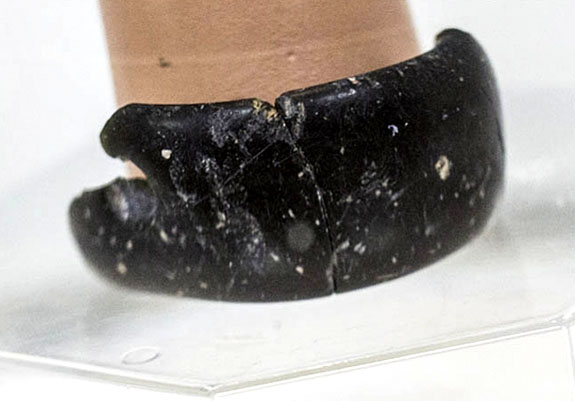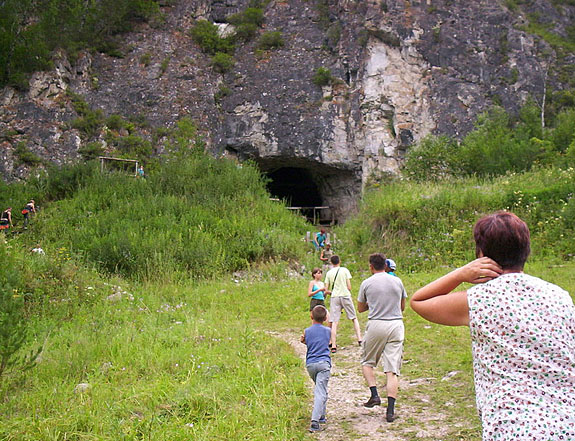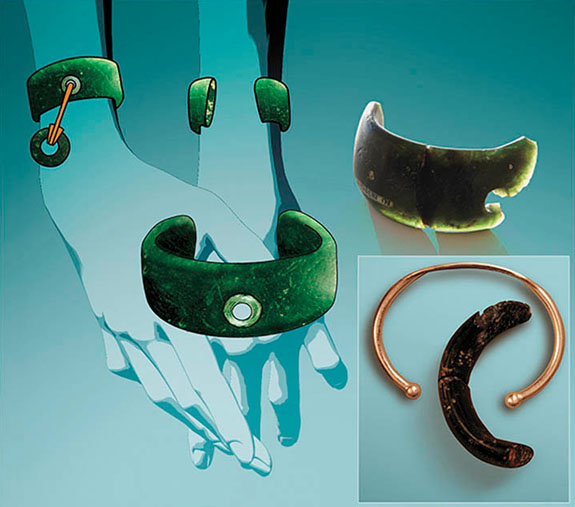May 12th, 2015
This beautifully polished calcite bracelet looks like a contemporary design, but it was actually made by our prehistoric human ancestors — the Denisovans — 40,000 years ago.

That’s the claim of Anatoly Derevyanko, Director of the Institute of Archaeology and Ethnography in Novosibirsk, part of the Siberian Branch of the Russian Academy of Sciences.
“The bracelet is stunning,” Derevyanko told the Siberian Times. “In bright sunlight it reflects the sun rays; at night by the fire it casts a deep shade of green.”

Besides having an eye for beauty and aesthetics, the Denisovans were skilled artisans and far more advanced than previously believed, noted Derevyanko. The 8mm round hole in the bracelet, for example, reveals that they were adept at using advanced tools, in this case a boring implement that was likely a high-rotation drill. They also showed advanced grinding and polishing skills.
“The skills of its creator were perfect,” added Irina Salnikova, head of the Museum of History and Culture of the Peoples of Siberia and the Far East in Novosibirsk. “Initially we thought that it was made by Neanderthals or modern humans, but it turned out that the master was Denisovan, at least in our opinion.”

The bracelet — which is believed to be the world’s oldest piece of jewelry crafted of stone — was discovered in the Denisova Cave, a famous archaeological site located in southwestern Siberia, in the Altai Mountains near the border with China and Mongolia.
Among the unique items previously discovered in the cave were remains from woolly mammoths and woolly rhinos. Also unearthed were the finger bone and two teeth from a juvenile female Denisovan, a now-extinct human species that was believed to be physically similar to Neanderthals.
Derevyanko also noted that chlorite is not found in the vicinity of the cave. The material is believed to have come from a source at least 125 miles away, which possibly reveals how valued the “imported” material was at the time.

The scientist also believes that the calcite bracelet was originally fashioned with other adornments, including some soft organic material, such as a leather strap that included a heavy charm.
The calcite bracelet is on display at the Museum of History and Culture of the Peoples of Siberia and the Far East in Novosibirsk.
Jewelry photos and graphics: Vera Salnitskaya, Anatoly Derevyanko, Mikhail Shunkov and Anastasia Abdulmanova via Siberian Times. Cave photo via Wikimedia Commons.

That’s the claim of Anatoly Derevyanko, Director of the Institute of Archaeology and Ethnography in Novosibirsk, part of the Siberian Branch of the Russian Academy of Sciences.
“The bracelet is stunning,” Derevyanko told the Siberian Times. “In bright sunlight it reflects the sun rays; at night by the fire it casts a deep shade of green.”

Besides having an eye for beauty and aesthetics, the Denisovans were skilled artisans and far more advanced than previously believed, noted Derevyanko. The 8mm round hole in the bracelet, for example, reveals that they were adept at using advanced tools, in this case a boring implement that was likely a high-rotation drill. They also showed advanced grinding and polishing skills.
“The skills of its creator were perfect,” added Irina Salnikova, head of the Museum of History and Culture of the Peoples of Siberia and the Far East in Novosibirsk. “Initially we thought that it was made by Neanderthals or modern humans, but it turned out that the master was Denisovan, at least in our opinion.”

The bracelet — which is believed to be the world’s oldest piece of jewelry crafted of stone — was discovered in the Denisova Cave, a famous archaeological site located in southwestern Siberia, in the Altai Mountains near the border with China and Mongolia.
Among the unique items previously discovered in the cave were remains from woolly mammoths and woolly rhinos. Also unearthed were the finger bone and two teeth from a juvenile female Denisovan, a now-extinct human species that was believed to be physically similar to Neanderthals.
Derevyanko also noted that chlorite is not found in the vicinity of the cave. The material is believed to have come from a source at least 125 miles away, which possibly reveals how valued the “imported” material was at the time.

The scientist also believes that the calcite bracelet was originally fashioned with other adornments, including some soft organic material, such as a leather strap that included a heavy charm.
The calcite bracelet is on display at the Museum of History and Culture of the Peoples of Siberia and the Far East in Novosibirsk.
Jewelry photos and graphics: Vera Salnitskaya, Anatoly Derevyanko, Mikhail Shunkov and Anastasia Abdulmanova via Siberian Times. Cave photo via Wikimedia Commons.


